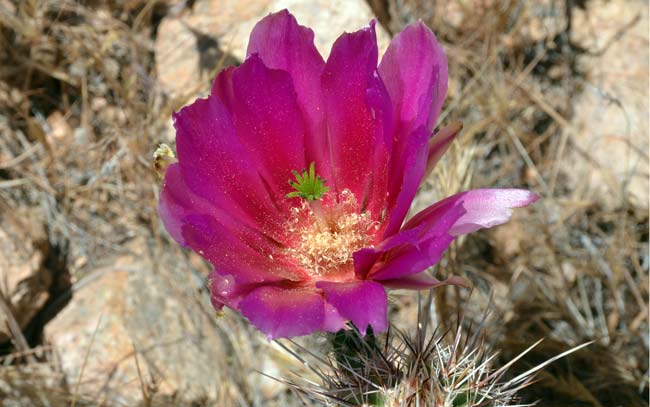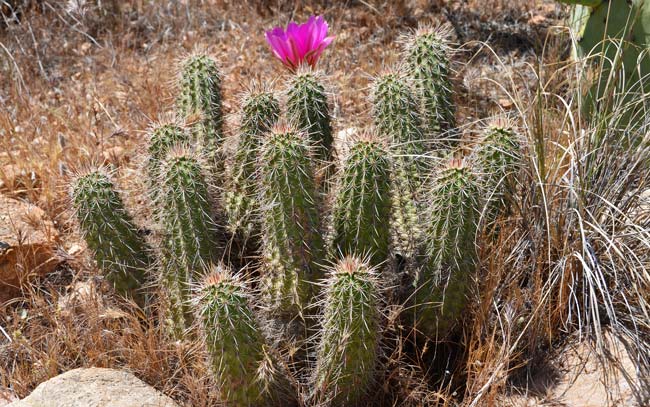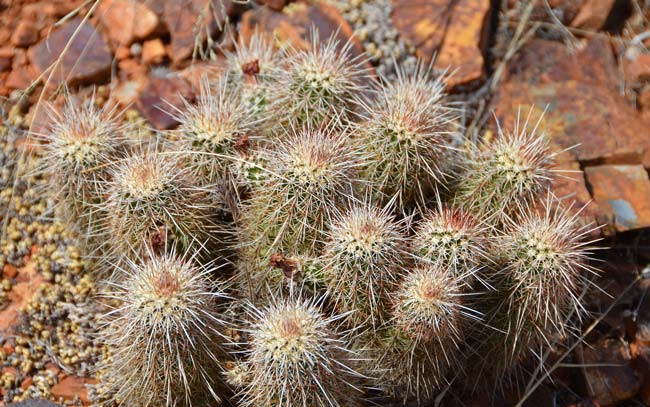Echinocereus fasciculatus, Pinkflower Hedgehog Cactus



Scientific Name: Echinocereus fasciculatus
Common Name: Pinkflower Hedgehog Cactus
Also Called:
Family: Cactaceae, Cactus Family
Synonyms: (Echinocereus abbeae, Echinocereus fasciculatus subsp. boyce-thompsonii, Echinocereus fasciculatus subsp. fasciculatus, Echinocereus fendleri var. fasciculatus, Echinocereus fendleri var. robustus, Echinocereus rectispinus var. robustus, Echinocereus reichenbachii var. robustus, Mammillaria fasciculata)
Status: Native
Duration: Perennial
Size: Up to 15 inches or so.
Growth Form: Shrub; plants in open clumps with 3 to 20 or more mostly erect cylindric stems.
Leaves: Leaves modified into spines emerging from areoles, about 8 to 16 spines per areole; lacking glochids; spines usually straight, yellowish, reddish brown or gray to black.
Flower Color: Rose-pink to magenta; flowers large and showy with 6 to 10 flowers per plant; inner tepals rose-pink to magenta with yellow and rarely white, with darker magenta or purplish-maroon mid-stripes; fruit bright red, orange-red or greenish, pulp white or pink.
Flowering Season: March to June or July; fruiting May to July.
Elevation: 2,500 to 5,000 feet.
Habitat Preferences: Sonoran Desert, flats, steep canyon sides, desert scrub, semi-desert grasslands, chaparral.
Recorded Range: In the United States Echinocereus fasciculatus is rare and found only in AZ and NM. It is also native to Sonora, Mexico. In Arizona it is found throughout the central parts of the state.
North America & US County Distribution Map for Echinocereus fasciculatus.
U.S. Weed Information: No information available.
Invasive/Noxious Weed Information: No information available.
Wetland Indicator: No information available.
Threatened/Endangered Information: Arizona: Echinocereus engelmannii is salvage restricted.
Genus Information: In North America there are 28 species for Echinocereus. Worldwide, The Plant List includes 64 accepted species names and a further 353 scientific names of infraspecific rank for the genus.
In the Southwestern United States: Arizona has 14 species of genus, California, Nevada and Utah each have 3 species, New Mexico has 12 species and Texas has 15 species. All data is approximate and subject to taxonomic changes.
Comments: Pinkflower Hedgehog Cactus is not always easily recognized in the field and has been confused with other species so similar as to have the same common name, ie Pink Flower Hedgehog (Echinocereus bonkerae and Echinocereus fendleri).
In Southwest Desert Flora also see: Pinkflower Hedgehog, Echinocereus bonkerae, Scarlet Hedgehog Cactus, Echinocereus coccineus, Hedgehog Cactus, Echinocereus engelmannii and Rainbow Hedgehog Cactus, Echinocereus rigidissimus.

